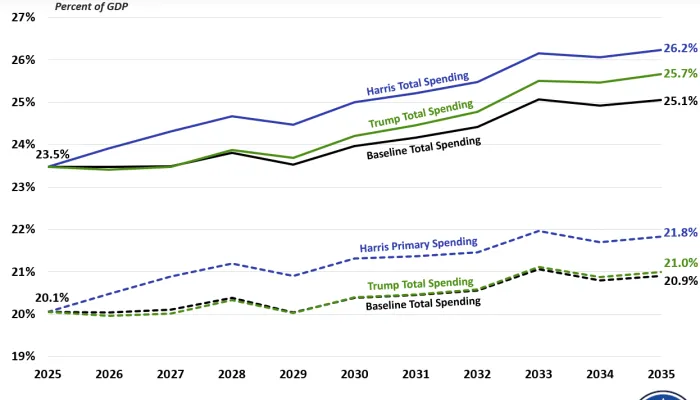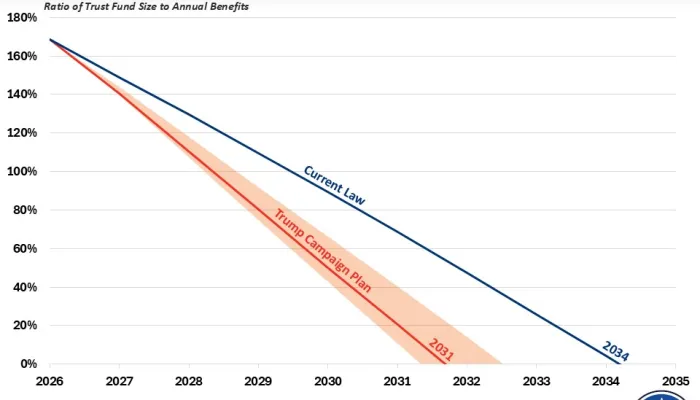Donald Trump’s 60% Tariff on Chinese Imports
Former President and current Republican presidential candidate Donald Trump recently proposed implementing a tariff of 60 percent or higher on imports from China. Although we estimate this would generate $2.4 trillion of net new revenue on a static basis, it would ultimately produce far less revenue – or even lose revenue – once changes in trade behavior are taken into account. Specifically, under conventional scoring we estimate it would produce no more than $300 billion over a decade and could lose $50 billion. On a macrodynamic basis, it would likely lose revenue under both scenarios.
| US Budget Watch 2024 is a project of the nonpartisan Committee for a Responsible Federal Budget designed to educate the public on the fiscal impact of presidential candidates’ proposals and platforms. Through the election, we will issue policy explainers, fact checks, budget scores, and other analyses. We do not support or oppose any candidate for public office. |
In addition to his proposed 10 percent universal baseline tariff, President Trump recently proposed increasing tariffs to 60 percent or more on all imports from China. Under current projections, we estimate the United States will import roughly $5.6 trillion of goods from China between Fiscal Year (FY) 2026 and 2035 at an average tariff rate of about 10 percent (up from 3 percent in 2017).
These estimates imply that raising the tariff to 60 percent would increase customs duties on Chinese imports in FY 2035 from about $65 billion to nearly $400 billion and would generate $2.4 trillion of net revenue over a decade on a static basis after accounting for income and payroll tax revenue offsets. However, assessing this policy on a static basis does not provide a meaningful revenue estimate.
In reality, such a large increase in tariffs would dramatically reduce trade with China (as intended) and thus lead to far less revenue than the static figure implies. Assuming elasticities consistent with trade literature, we estimate this tariff increase would reduce imports from China by about 85 percent. Despite the much higher tariff rates on remaining imports, tariff revenue on Chinese goods would fall from roughly $65 billion to $55 billion in FY 2035 under this scenario.
Assuming Chinese imports are replaced entirely by domestic production, the Treasury would absorb nearly all that revenue loss. If, on the other hand, replacement goods were imported from other countries subject to Trump’s proposed 10 percent baseline tariff, tariff revenue in FY 2035 on Chinese imports and their replacements would grow to above $100 billion.

When incorporating impacts on individual and corporate income taxes and payroll taxes, on a conventional basis we estimate the policy would generate as much as $300 billion in net revenue over a decade or lose as much as $50 billion, again depending on what share of Chinese imports are replaced with domestic versus foreign goods.
Those figures would be lower after incorporating macroeconomic effects. For example, assuming the tariffs and responses reduced economic output by about 1 percent – consistent with the similar-sized universal baseline tariff – the policy could lose between $200 and $500 billion over a decade.
Net Revenue Impact of President Trump's 60% Tariff Proposal
| Low | High | |
|---|---|---|
| Static (no change in trade) | $2.4 trillion | $2.4 trillion |
| Conventional* | -$50 billion | $300 billion |
Sources: Committee for a Responsible Federal Budget, U.S. Census Bureau, Congressional Budget Office.
Notes: Conventional estimates assume tariffs would reduce import levels consistent with an import elasticity of 1.7 and that roughly half the tariff revenue would be subject to income and payroll tax revenue offsets. *Under the "High" scenario an elasticity of 1.7 is applied to diverted trade as well, but other than a 10 percent universal baseline tariff we assume no additional costs in changing the source of imports from China to other countries.
Importantly, even tariffs that do not reduce deficits could theoretically have other benefits – including reducing economic reliance on China, helping support some domestic industries, and strengthening our national security.
However, while some tariff increases can meaningfully bolster revenue and reduce debt, very large increases are likely to diminish and even reverse those fiscal gains. In this particular case, we estimate that a 60 percent tariff on all goods imports from China would generate less than $300 billion and could actually lose revenue.
*****
Throughout the 2024 presidential election cycle, US Budget Watch 2024 will bring information and accountability to the campaign by analyzing candidates’ proposals, fact-checking their claims, and scoring the fiscal cost of their agendas.
By injecting an impartial, fact-based approach into the national conversation, US Budget Watch 2024 will help voters better understand the nuances of the candidates’ policy proposals and what they would mean for the country’s economic and fiscal future.
You can find more US Budget Watch 2024 content here.


